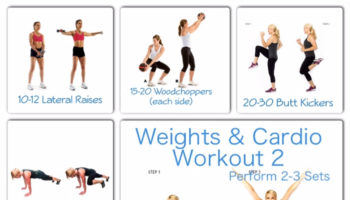Contents
Strength training exercises for seniors at Home
Physical activity is essential to healthy aging. As an older adult, regular physical activity is one of the most important things you can do for your health. It can prevent many of the health problems that seem to come with age. It also helps your muscles grow stronger so you can keep doing your day-to-day activities without becoming dependent on others. In fact, in most cases you have more to lose by not being active.
Here are just a few of the benefits. Exercise and physical activity 1:
- Can help maintain and improve your physical strength and fitness.
- Can help improve your ability to do the everyday things you want to do.
- Can help improve your balance.
- Can help manage and improve diseases like diabetes, heart disease, and osteoporosis.
- Can help reduce feelings of depression and may improve mood and overall well-being.
- May improve your ability to shift quickly between tasks, plan an activity, and ignore irrelevant information.
The key word in all these benefits is YOU — how fit and active you are now and how much effort you put into being active. To gain the most benefits, enjoy all types of exercise, stay safe while you exercise, and be sure to eat a healthy diet, too!
Not doing any physical activity can be bad for you, no matter your age or health condition. Keep in mind, some physical activity is better than none at all. Your health benefits will also increase with the more physical activity that you do.
Strength training (also referred to as resistance training) enables seniors to improve their overall health and fitness by increasing muscular strength, endurance, and bone density and by improving their insulin sensitivity and glucose metabolism 2.
For older adults (i.e., persons aged >65 years), strength-training exercises are recommended to decrease the risk for falls and fractures 3 and to promote independent living 4. The American College of Sports Medicine recommends that adults include strength training as part of a comprehensive physical activity program 2.
If you’re 65 years of age or older, are generally fit, and have no limiting health conditions you can follow the guidelines listed below.
Seniors need at least:
- 2 hours and 30 minutes (150 minutes) of moderate-intensity aerobic activity (i.e., brisk walking) every week and
- Weight training muscle-strength training activities on 2 or more days a week that work all major muscle groups (legs, hips, back, abdomen, chest, shoulders, and arms).
For even greater health benefits
Older adults should increase their activity to:
- Jogging 5 hours (300 minutes) each week of moderate-intensity aerobic activity and
- Weight training muscle-strength training activities on 2 or more days a week that work all major muscle groups (legs, hips, back, abdomen, chest, shoulders, and arms).
What are Muscle-Strength Training activities ?
Besides aerobic activity, you need to do things to make your muscles stronger at least 2 days a week. These types of activities will help keep you from losing muscle as you get older.
To strengthen your muscles, you need to lift or push weight. Stronger muscles can make it easier to do everyday things like get up from a chair, climb stairs, carry groceries, open jars, and even play with your grandchildren. Lower-body strength exercises also will improve your balance.
To gain health benefits, muscle-strengthening activities need to be done to the point where it’s hard for you to do another repetition without help. A repetition is one complete movement of an activity, like lifting a weight or doing one sit-up. Try to do 8—12 repetitions per activity that count as 1 set. Try to do at least 1 set of muscle-strengthening activities, but to gain even more benefits, do 2 or 3 sets.
There are many ways you can strengthen your muscles, whether it’s at home or the gym. The activities you choose should work all the major muscle groups of your body (legs, hips, back, chest, abdomen, shoulders, and arms). You may want to try:
- Lifting weights
- Working with resistance bands
- Doing exercises that use your body weight for resistance (push ups, sit ups)
- Heavy gardening (digging, shoveling)
- Yoga.
Safety tips for strength exercises
If you are new to strength training or it’s been a while since you’ve done a particular exercise, talk with your health care provider to make sure that exercise is appropriate. If you’ve had hip or back surgery, talk about which exercises might be best for you.
Exercise should NOT cause severe pain. Exhaustion, sore joints, or painful muscle pulling mean you’re overdoing it.
- Breathe when you exercise! Breathe out as you lift or push, and breathe in as you relax. If you’re doing leg lifts, for example, breathe out as you lift your leg, and breathe in as you lower it.
- Use smooth, steady movements to lift weights into position. Don’t jerk or thrust weights.
- Keep arm and leg joints slightly bent. Avoid “locking” your arm and leg joints in a tightly straight position.
- Take 3 seconds to lift or push weight into place, hold the position for 1 second, and then take another 3 seconds to return to your starting position. Control the movement, and don’t let the weights drop.
- If it’s difficult to hold hand weights properly, try using wrist weights.
- If you are starting an exercise program or your arms feel tired after several repetitions, complete the exercise by using one arm at a time. Alternate sides, and then work your way up to using both arms at the same time.
- A steady rate of progress is the best approach. Over-exercising can cause injury.
- Challenge yourself, but listen to your body, and use common sense when you exercise.
Upper Body Strength Exercises for Seniors
Hand Grip
This simple exercise should help if you have trouble picking things up or holding on to them. It also will help you open things like that pickle jar more easily. You can even do this exercise while reading or watching TV.
- Hold a tennis ball or other small rubber or foam ball in one hand.
- Slowly squeeze the ball as hard as you can and hold it for 3-5 seconds.
- Relax the squeeze slowly.
- Repeat 10-15 times.
- Repeat 10-15 times with other hand.
- Repeat 10-15 times more with each hand.
Figure 1. Hand Grip Strength Exercise for Seniors (you’ll need either a tennis ball, small rubber or foam ball)
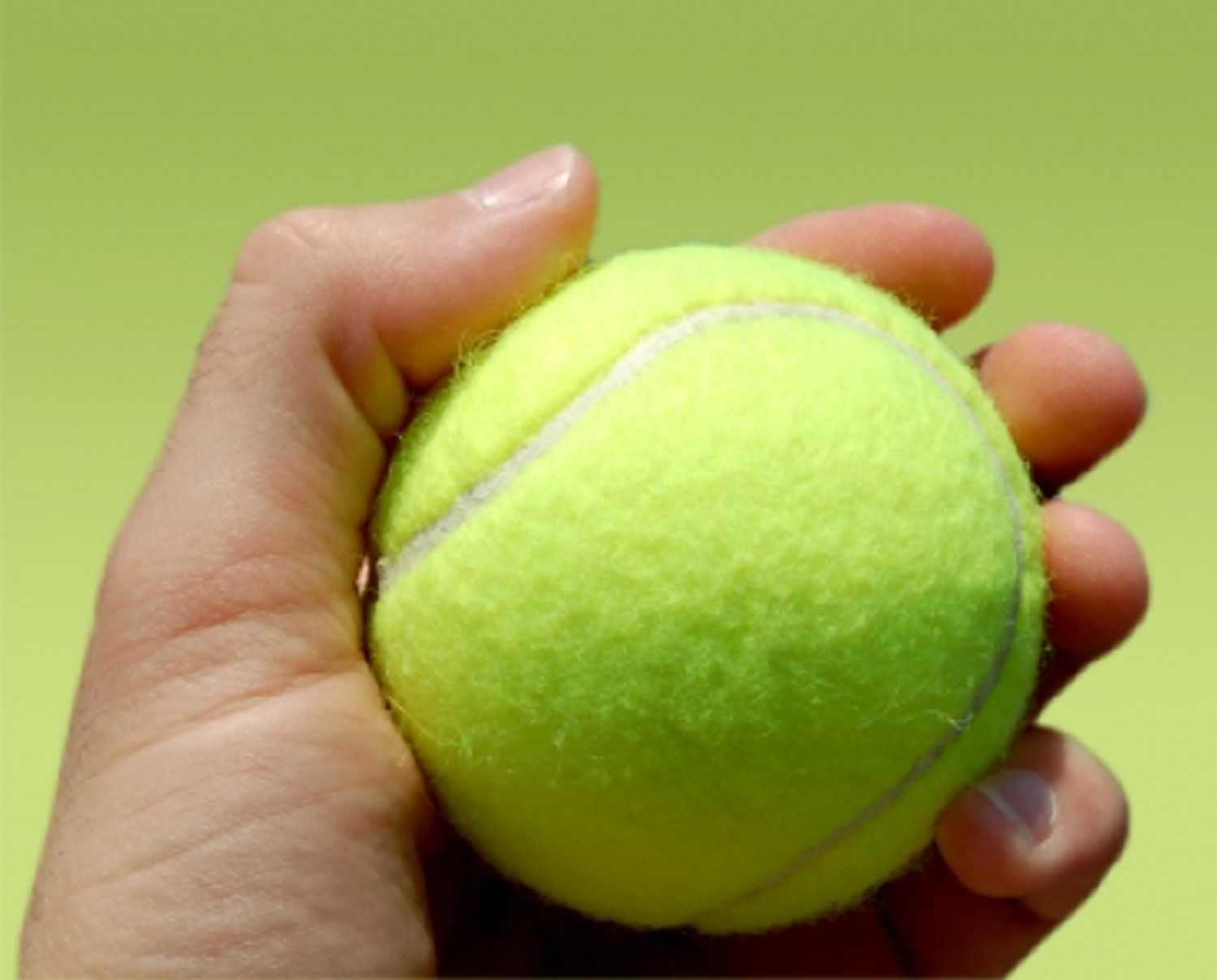
Wrist Curl
This exercise will strengthen your wrists. It also will help ensure good form and prevent injury when you do upper body strength exercises.
- Rest your forearm on the arm of a sturdy chair with your hand over the edge.
- Hold weight with palm facing upward.
- Slowly bend your wrist up and down.
- Repeat 10-15 times.
- Repeat with other hand 10-15 times.
- Repeat 10-15 more times with each hand.
Figure 2. Wrist Curl Strength Exercise for Seniors (you’ll need hand-held weight)
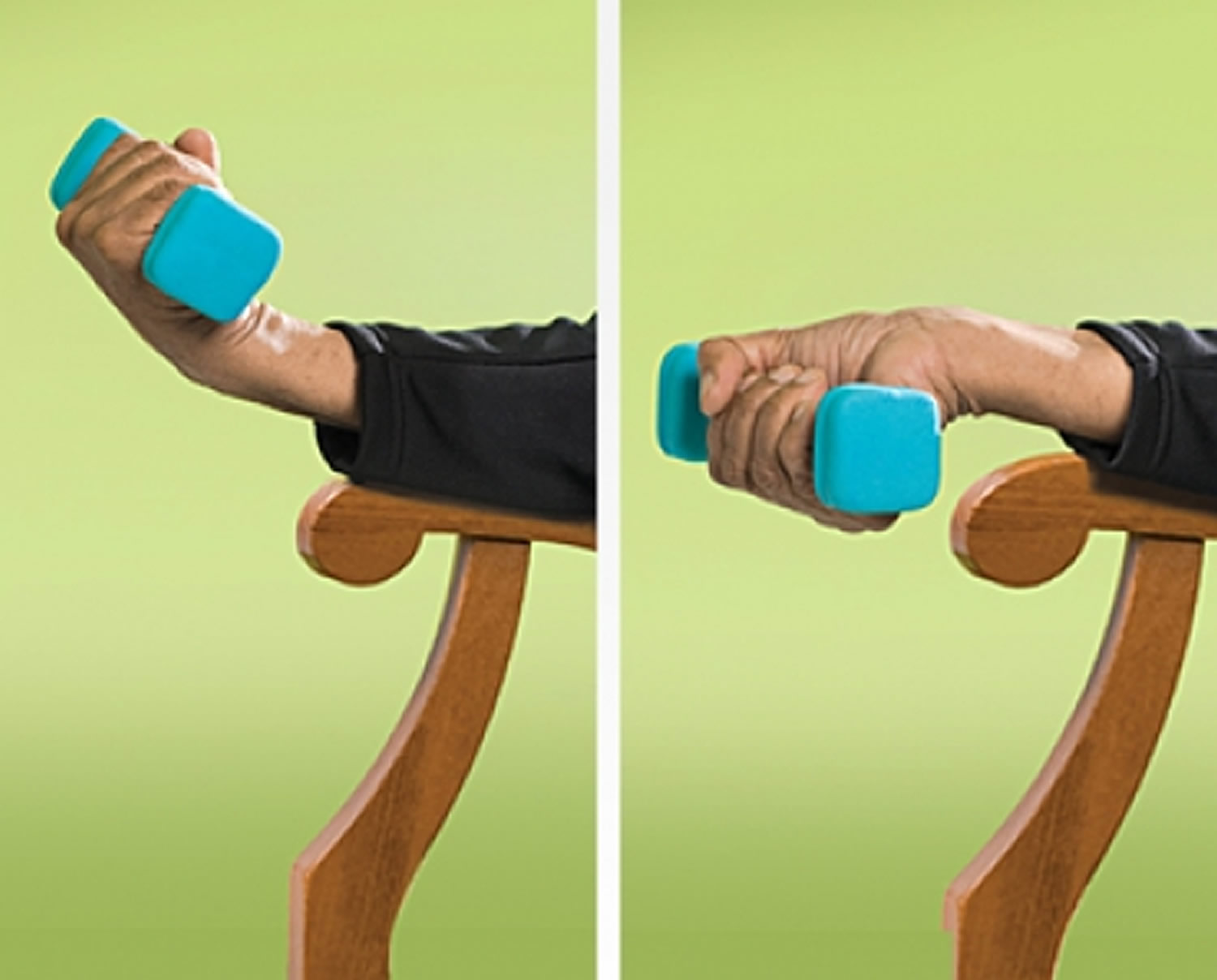
Overhead Arm Raise
This exercise will strengthen your shoulders and arms. It should make swimming and other activities such as lifting and carrying grandchildren easier.
- You can do this exercise while standing or sitting in a sturdy, armless chair.
- Keep your feet flat on the floor, shoulder-width apart.
- Hold weights at your sides at shoulder height with palms facing forward. Breathe in slowly.
- Slowly breathe out as you raise both arms up over your head keeping your elbows slightly bent.
- Hold the position for 1 second.
- Breathe in as you slowly lower your arms.
- Repeat 10-15 times.
- Rest; then repeat 10-15 more times.
Figure 3. Overhead Arm Raise Strength Exercise for Seniors (you’ll need hand-held weight)
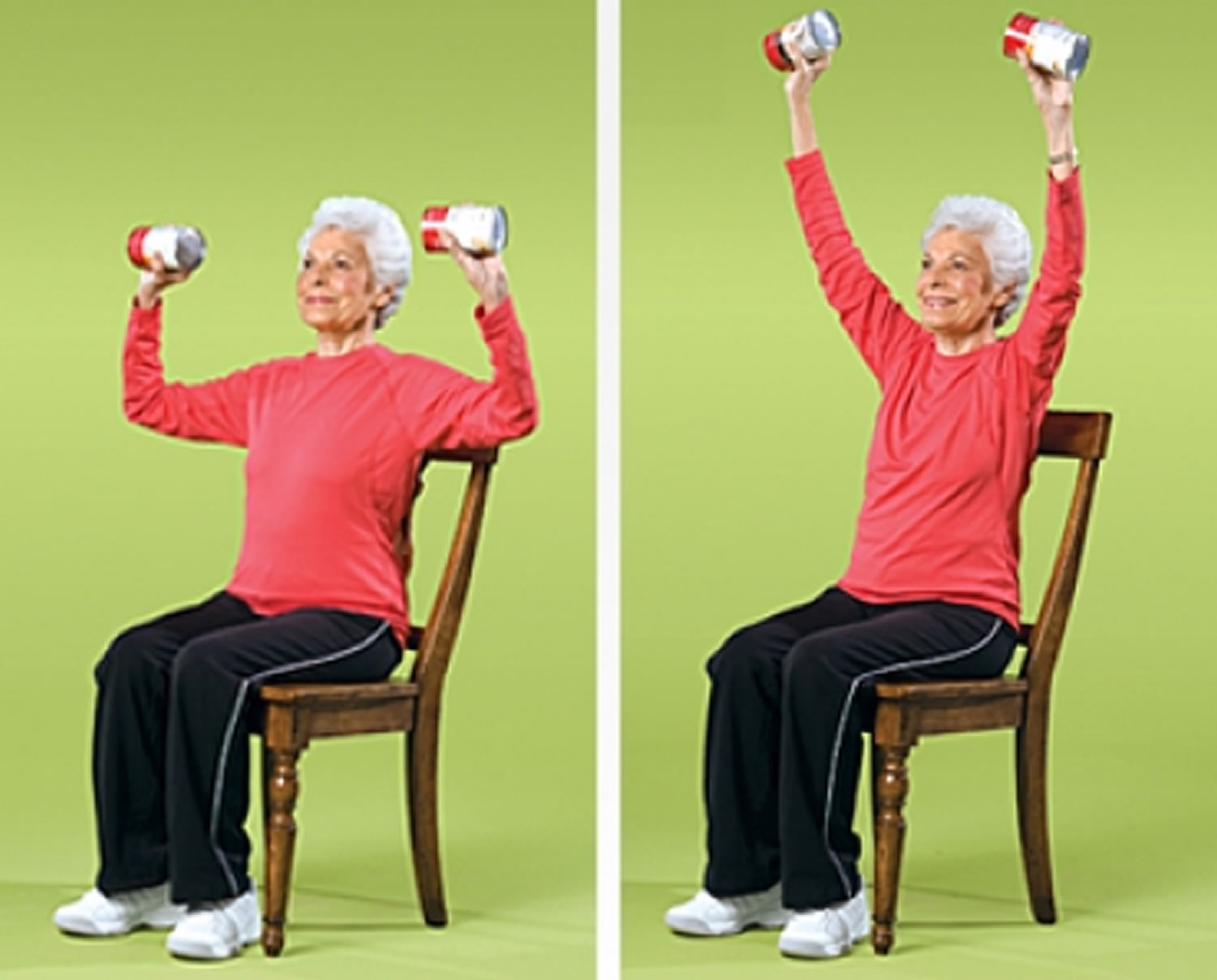
Front Arm Raise
This exercise for your shoulders can help you put things up on a shelf or take them down more easily.
- Stand with your feet shoulder-width apart.
- Hold weights straight down at your sides, with palms facing backward.
- Keeping them straight, breathe out as you raise both arms in front of you to shoulder height.
- Hold the position for 1 second.
- Breathe in as you slowly lower arms.
- Repeat 10-15 times.
- Rest; then repeat 10-15 more times.
Figure 4. Front Arm Raise Strength Exercise for Seniors (you’ll need hand-held weight)

Side Arm Raise
This exercise will strengthen your shoulders and make lifting groceries easier.
- You can do this exercise while standing or sitting in a sturdy, armless chair.
- Keep your feet flat on the floor, shoulder-width apart.
- Hold hand weights straight down at your sides with palms facing inward. Breathe in slowly.
- Slowly breathe out as you raise both arms to the side, shoulder height.
- Hold the position for 1 second.
- Breathe in as you slowly lower your arms.
- Repeat 10-15 times.
- Rest; then repeat 10-15 more times.
Figure 5. Side Arm Raise Strength Exercise for Seniors (you’ll need hand-held weight)
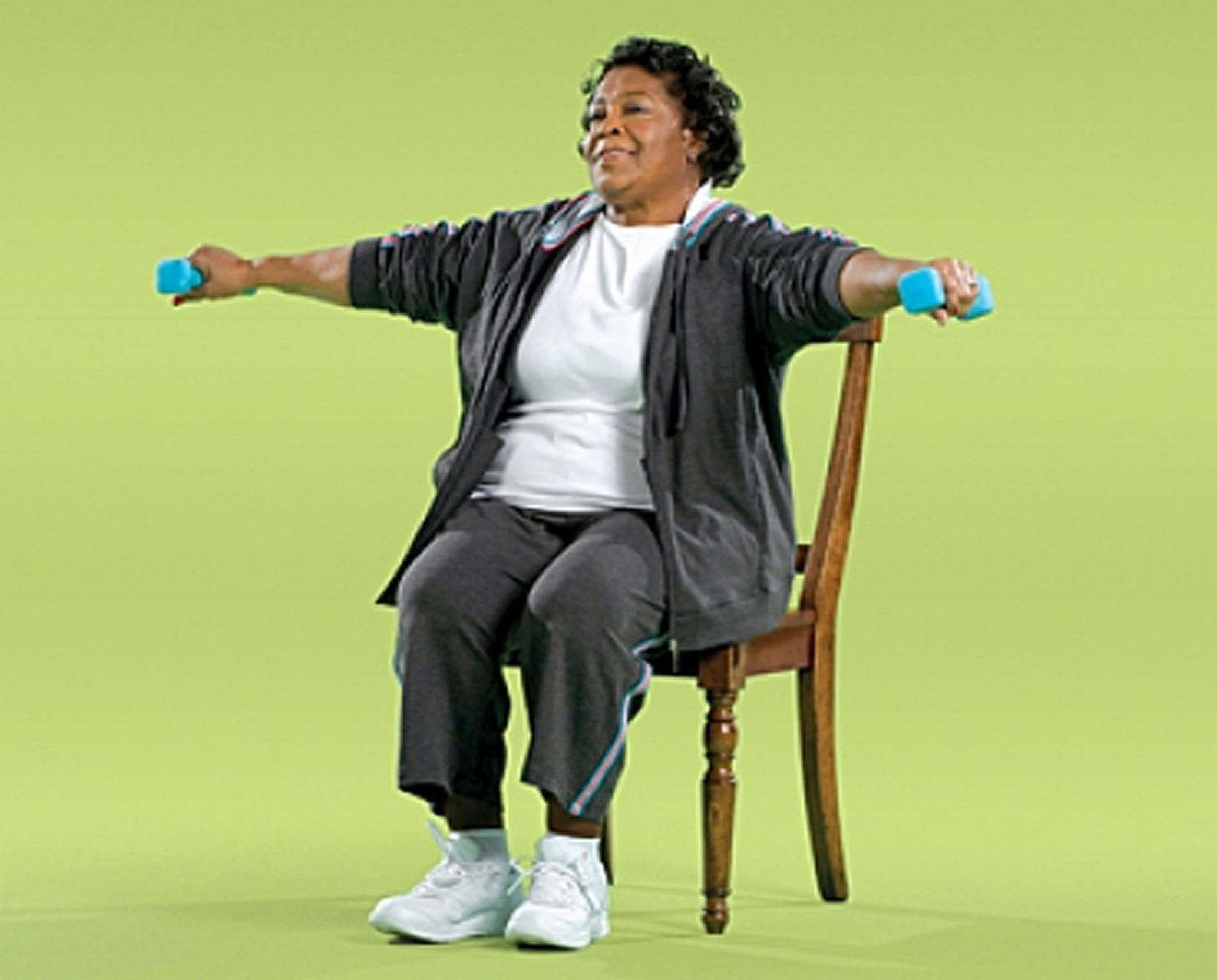
Arm Curl
After a few weeks of doing this exercise for your upper arm muscles, lifting that gallon of milk will be much easier.
- Stand with your feet shoulder-width apart.
- Hold weights straight down at your sides, palms facing forward. Breathe in slowly.
- Breathe out as you slowly bend your elbows and lift weights toward chest. Keep elbows at your sides.
- Hold the position for 1 second.
- Breathe in as you slowly lower your arms.
- Repeat 10-15 times.
- Rest; then repeat 10-15 more times.
Figure 6. Arm Curl Strength Exercise for Seniors (you’ll need hand-held weight)

Arm Curl with Resistance Band
This variation of the Arm Curl uses a resistance band instead of weights.
- Sit in a sturdy, armless chair with your feet flat on the floor, shoulder-width apart.
- Place the center of the resistance band under both feet. Hold each end of the band with palms facing inward. Keep elbows at your sides. Breathe in slowly.
- Keep wrists straight and slowly breathe out as you bend your elbows and bring your hands toward your shoulders.
- Hold the position for 1 second.
- Breathe in as you slowly lower your arms.
- Repeat 10-15 times.
- Rest; then repeat 10-15 more times.
Figure 7. Arm Curl with Resistance Band Strength Exercise for Seniors (you’ll need resistance band and sturdy, armless chair)

Seated Row with Resistance Band
This exercise to strengthen upper back, shoulder, and neck muscles should make everyday activities such as raking and vacuuming easier.
- Sit in a sturdy, armless chair with your feet flat on the floor, shoulder-width apart.
- Place the center of the resistance band under both feet. Hold each end of the band with palms facing inward.
- Relax your shoulders and extend your arms beside your legs. Breathe in slowly.
- Breathe out slowly and pull both elbows back until your hands are at your hips.
- Hold position for 1 second.
- Breathe in as you slowly return your hands to the starting position.
- Repeat 10-15 times
- Rest; then repeat 10-15 more times.
Figure 8. Seated Row with Resistance Band Strength Exercise for Seniors (you’ll need resistance band and sturdy, armless chair)
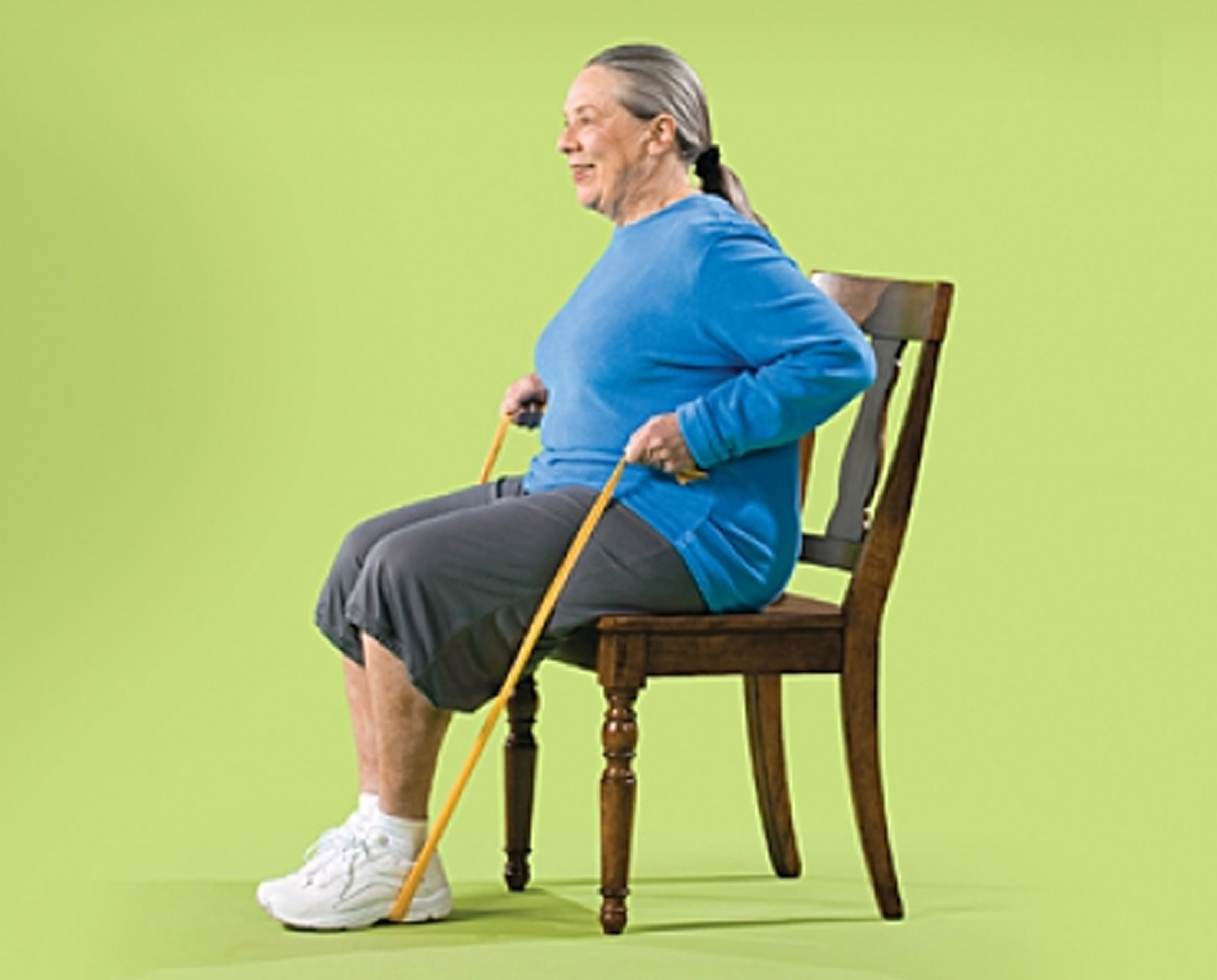
Wall Push-Up
These push-ups will strengthen your arms, shoulders, and chest. Try this exercise during a TV commercial break.
- Face a wall, standing a little farther than arm’s length away, feet shoulder-width apart.
- Lean your body forward and put your palms flat against the wall at shoulder height and shoulder-width apart.
- Slowly breathe in as you bend your elbows and lower your upper body toward the wall in a slow, controlled motion. Keep your feet flat on the floor.
- Hold the position for 1 second.
- Breathe out and slowly push yourself back until your arms are straight.
- Repeat 10-15 times.
- Rest; then repeat 10-15 more times.
Figure 9. Wall Push-Up Strength Exercise for Seniors

Elbow Extension
This exercise will strengthen your upper arms. If your shoulders aren’t flexible enough to do this exercise, try the Chair Dip.
- You can do this exercise while standing or sitting in a sturdy, armless chair.
- Keep your feet flat on the floor, shoulder-width apart.
- Hold weight in one hand with palm facing inward. Raise that arm toward ceiling.
- Support this arm below elbow with other hand. Breathe in slowly.
- Slowly bend raised arm at elbow and bring weight toward shoulder.
- Hold position for 1 second.
- Breathe out and slowly straighten your arm over your head. Be careful not to lock your elbow.
- Repeat 10-15 times.
- Repeat 10-15 times with other arm.
- Repeat 10-15 more times with each arm.
Figure 10. Elbow Extension Strength Exercise for Seniors (you’ll need hand-held weight)
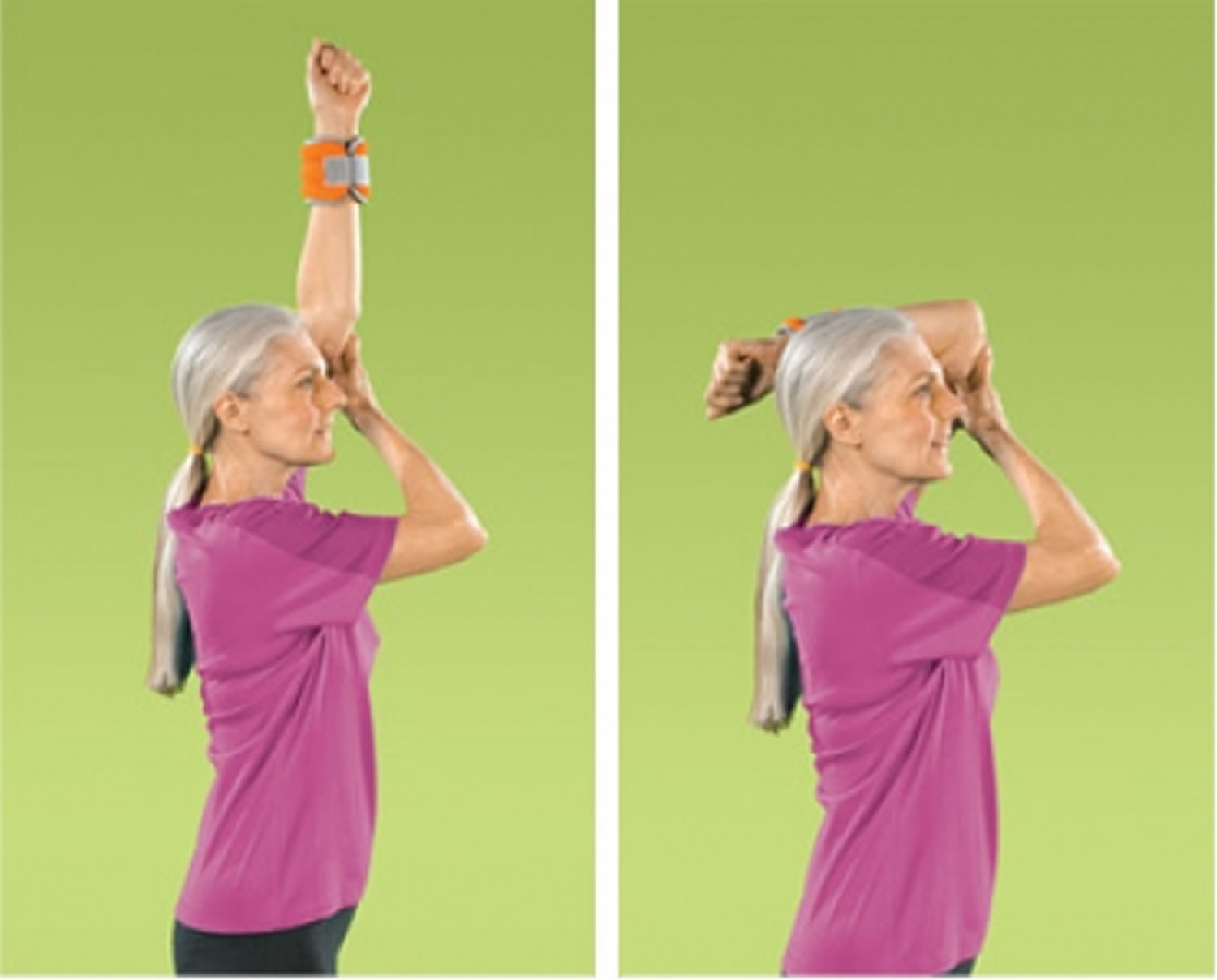
Chair Dip
This pushing motion will strengthen your arm muscles even if you are not able to lift yourself up off the chair.
- Sit in a sturdy chair with armrests with your feet flat on the floor, shoulder-width apart.
- Lean slightly forward; keep your back and shoulders straight.
- Grasp arms of chair with your hands next to you. Breathe in slowly.
- Breathe out and use your arms to push your body slowly off the chair.
- Hold position for 1 second.
- Breathe in as you slowly lower yourself back down.
- Repeat 10-15 times.
- Rest; then repeat 10-15 more times.
Figure 11. Chair Dip Strength Exercise for Seniors (you’ll need sturdy chair with armrests)

Lower Body Strength Exercises for Seniors
Back Leg Raise
This exercise strengthens your buttocks and lower back. For an added challenge, you can modify the exercise to improve your balance.
- Stand behind a sturdy chair, holding on for balance. Breathe in slowly.
- Breathe out and slowly lift one leg straight back without bending your knee or pointing your toes. Try not to lean forward. The leg you are standing on should be slightly bent.
- Hold position for 1 second.
- Breathe in as you slowly lower your leg.
- Repeat 10-15 times.
- Repeat 10-15 times with other leg.
- Repeat 10-15 more times with each leg.
Figure 12. Back Leg Raise Strength Exercise for Seniors (you’ll need a sturdy chair)

Side Leg Raise
This exercise strengthens hips, thighs, and buttocks. For an added challenge, you can modify the exercise to improve your balance.
- Stand behind a sturdy chair with feet slightly apart, holding on for balance. Breathe in slowly.
- Breathe out and slowly lift one leg out to the side. Keep your back straight and your toes facing forward. The leg you are standing on should be slightly bent.
- Hold position for 1 second.
- Breathe in as you slowly lower your leg.
- Repeat 10-15 times.
- Repeat 10-15 times with other leg.
- Repeat 10-15 more times with each leg.
Figure 13. Side Leg Raise Strength Exercise for Seniors (you’ll need a sturdy chair)
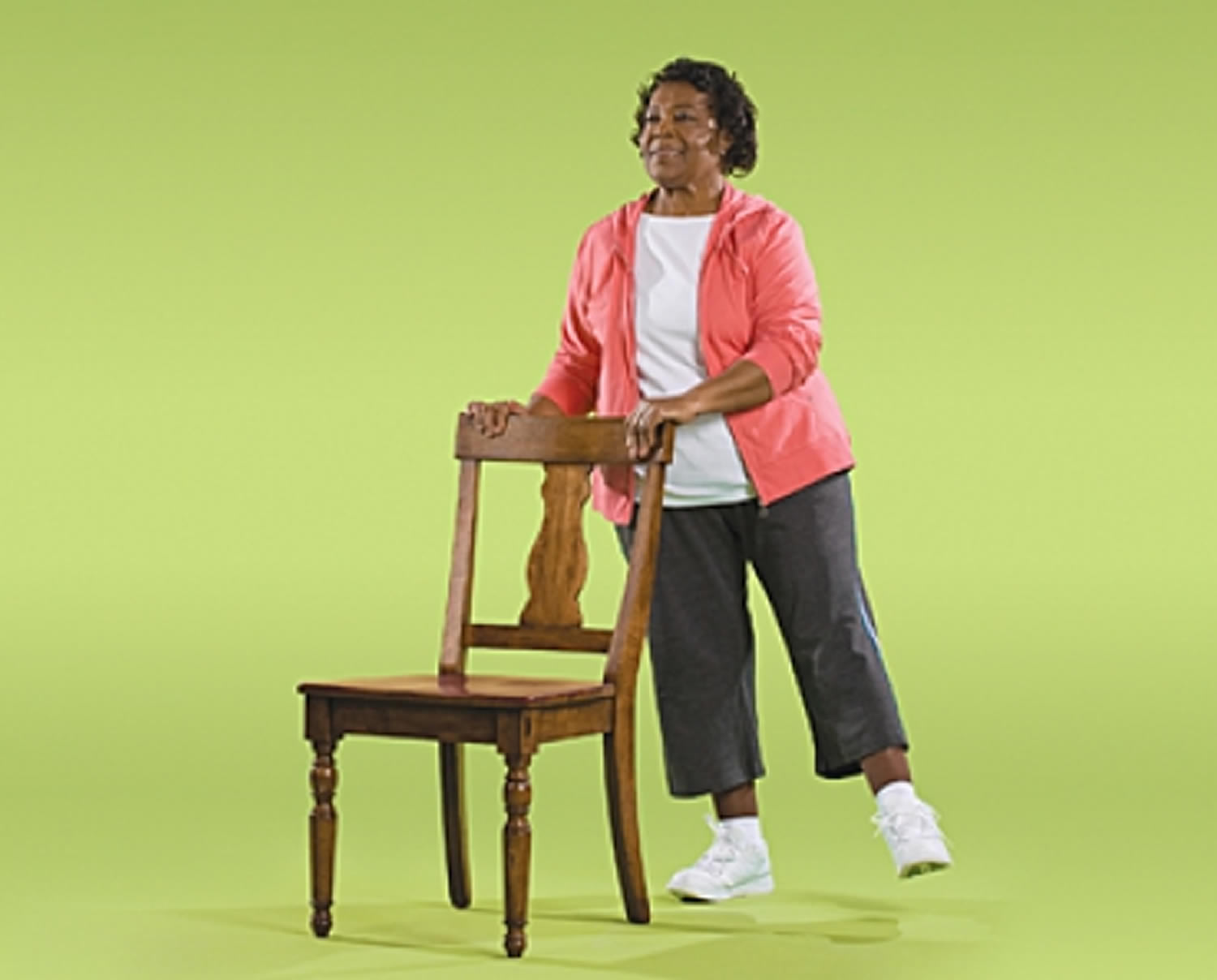
Knee Curl
Walking and climbing stairs are easier when you do both the Knee Curl and Leg Straightening exercises. For an added challenge, you can modify the exercise to improve your balance.
- Stand behind a sturdy chair, holding on for balance. Lift one leg straight back without bending your knee or pointing your toes. Breathe in slowly.
- Breathe out as you slowly bring your heel up toward your buttocks as far as possible. Bend only from your knee, and keep your hips still. The leg you are standing on should be slightly bent.
- Hold position for 1 second.
- Breathe in as you slowly lower your foot to the floor.
- Repeat 10-15 times.
- Repeat 10-15 times with other leg.
- Repeat 10-15 more times with each leg.
Figure 14. Knee Curl Strength Exercise for Seniors (you’ll need a sturdy chair)
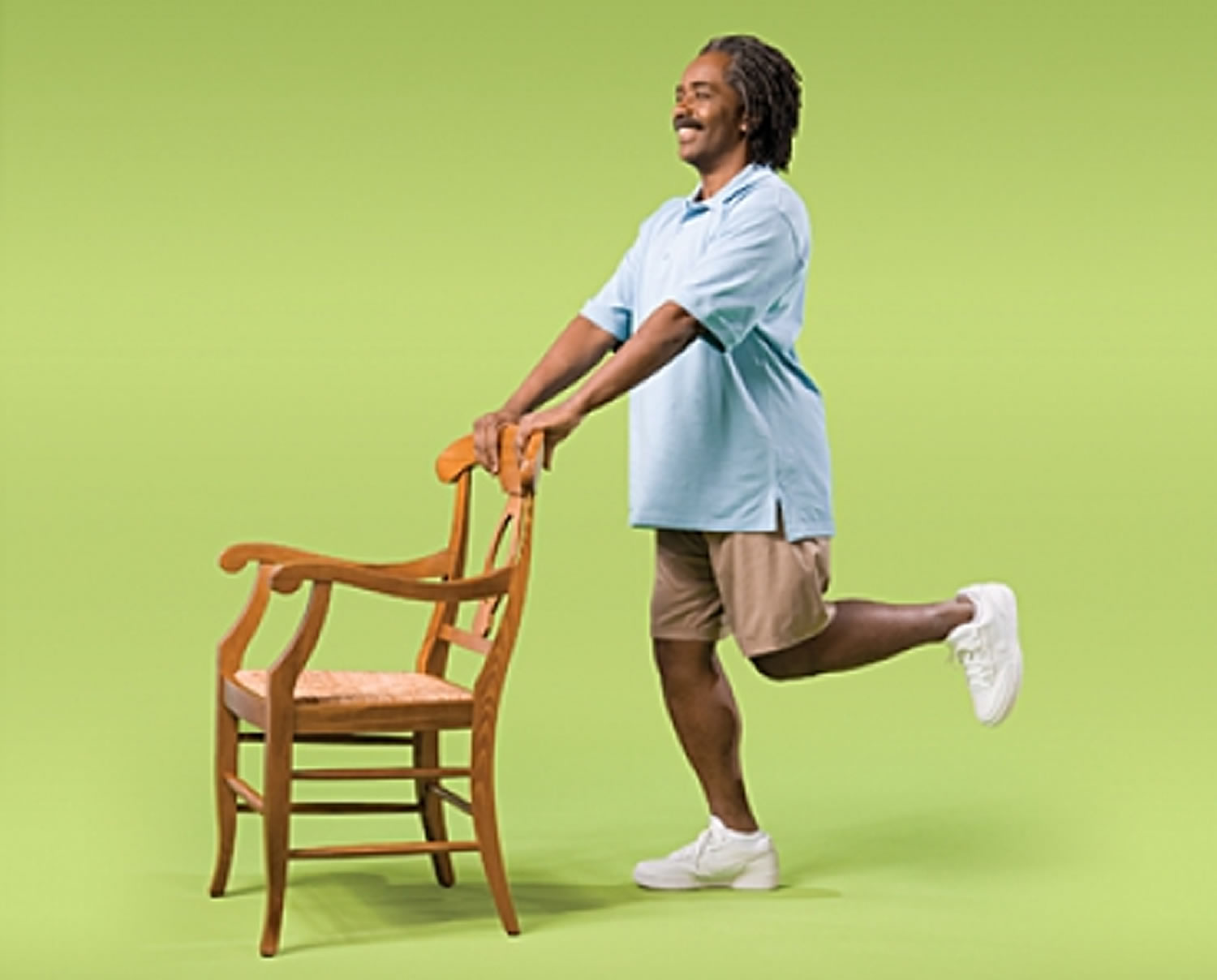
Leg Straightening
This exercise strengthens your thighs and may reduce symptoms of arthritis of the knee.
- Sit in a sturdy chair with your back supported by the chair. Only the balls of your feet and your toes should rest on the floor. Put a rolled bath towel at the edge of the chair under thighs for support. Breathe in slowly.
- Breathe out and slowly extend one leg in front of you as straight as possible, but don’t lock your knee.
- Flex foot to point toes toward the ceiling. Hold position for 1 second.
- Breathe in as you slowly lower leg back down.
- Repeat 10-15 times.
- Repeat 10-15 times with other leg.
- Repeat 10-15 more times with each leg.
Figure 15. Leg Straightening
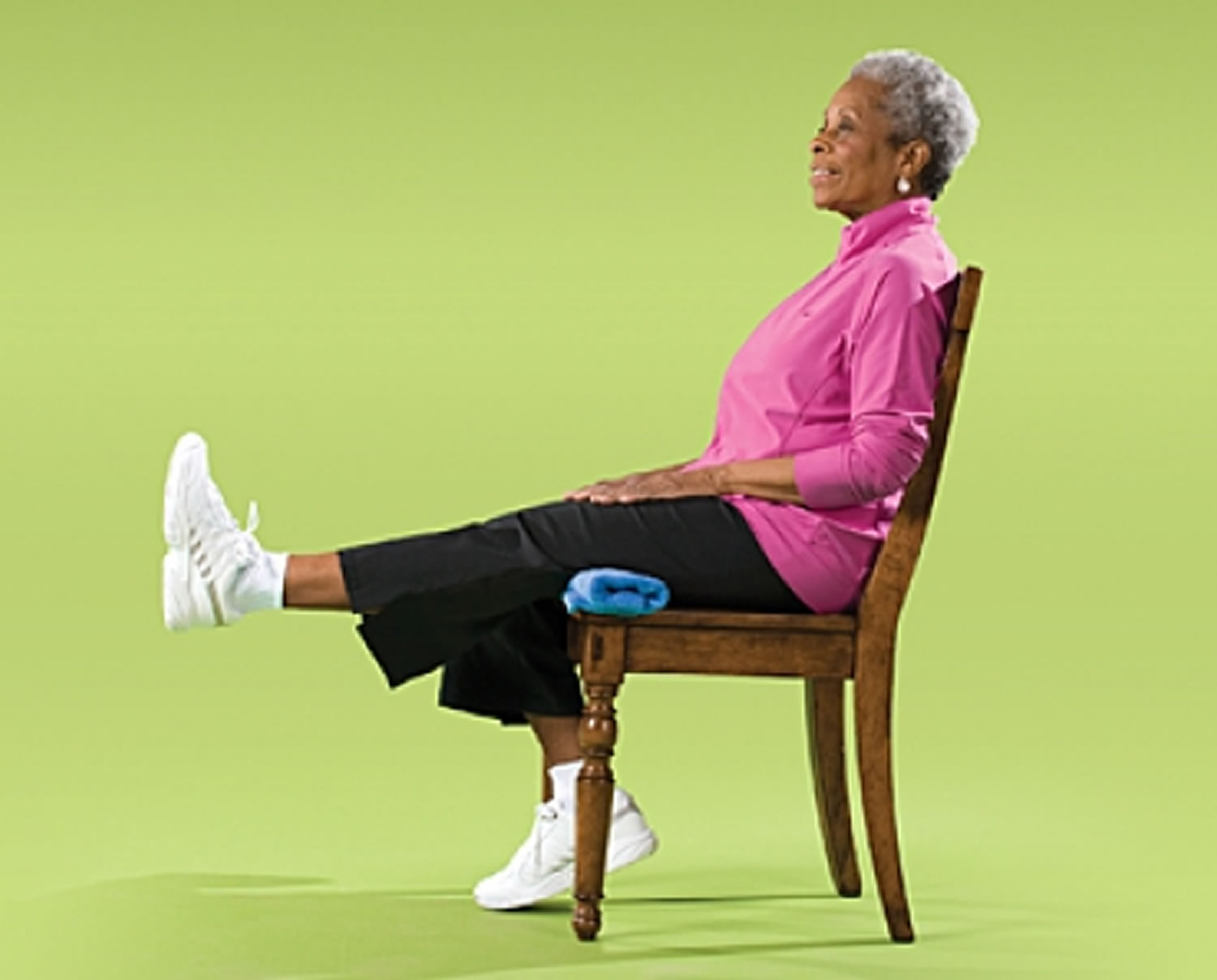
Chair Stand
This exercise, which strengthens your abdomen and thighs, will make it easier to get in and out of the car. If you have knee or back problems, talk with your doctor before trying this exercise.
- Sit toward the front of a sturdy, armless chair with knees bent and feet flat on floor, shoulder-width apart.
- Lean back with your hands crossed over your chest. Keep your back and shoulders straight throughout exercise. Breathe in slowly.
- Breathe out and bring your upper body forward until sitting upright.
- Extend your arms so they are parallel to the floor and slowly stand up.
- Breathe in as you slowly sit down.
- Repeat 10-15 times.
- Rest; then repeat 10-15 more times.
Figure 16. Chair Stand Strength Exercise for Seniors (you’ll need a sturdy chair)

Toe Stand
This exercise will help make walking easier by strengthening your calves and ankles. For an added challenge, you can modify the exercise to improve your balance.
- Stand behind a sturdy chair, feet shoulder-width apart, holding on for balance. Breathe in slowly.
- Breathe out and slowly stand on tiptoes, as high as possible.
- Hold position for 1 second.
- Breathe in as you slowly lower heels to the floor.
- Repeat 10-15 times.
- Rest; then repeat 10-15 more times.
Figure 17. Toe Stand Strength Exercise for Seniors (you’ll need a sturdy chair)

What is aerobic activity for seniors ?
Aerobic activity or “cardio” gets you breathing harder and your heart beating faster. From pushing a lawn mower, to taking a dance class, to biking to the store – all types of activities count. As long as you’re doing them at a moderate or vigorous intensity for at least 10 minutes at a time. Even something as simple as walking is a great way to get the aerobic activity you need, as long as it’s at a moderately intense pace.
Intensity is how hard your body is working during aerobic activity.
How do you know if you’re doing moderate or vigorous aerobic activity ?
On a 10-point scale, where sitting is 0 and working as hard as you can is 10, moderate-intensity aerobic activity is a 5 or 6. It will make you breathe harder and your heart beat faster. You’ll also notice that you’ll be able to talk, but not sing the words to your favorite song.
Vigorous-intensity activity is a 7 or 8 on this scale. Your heart rate will increase quite a bit and you’ll be breathing hard enough so that you won’t be able to say more than a few words without stopping to catch your breath.
You can do moderate- or vigorous-intensity aerobic activity, or a mix of the two each week. Intensity is how hard your body is working during aerobic activity. A rule of thumb is that 1 minute of vigorous-intensity activity is about the same as 2 minutes of moderate-intensity activity.
Everyone’s fitness level is different. This means that walking may feel like a moderately intense activity to you, but for others, it may feel vigorous. It all depends on you – the shape you’re in, what you feel comfortable doing, and your health condition. What’s important is that you do physical activities that are right for you and your abilities.
- How Exercise Can Help You. https://go4life.nia.nih.gov/how-exercise-can-help-you[↩]
- American College of Sports Medicine. Position stand: the recommended quantity and quality of exercise for developing and maintaining cardiorespiratory and muscular fitness, and flexibility in healthy adults. Med Sci Sports Exerc 1998;30:975-91.[↩][↩]
- Christmas C, Andersen RA. Exercise and older patients: guidelines for the clinician. J Am Geriatr Soc 2000;48:318-24.[↩]
- National Institute on Aging. Exercise: A Guide from the National Institute on Aging. Bethesda, Maryland: U.S. Department of Health and Human Services, National Institutes of Health, National Institutes on Aging, 2017. https://go4life.nia.nih.gov/how-exercise-can-help-you[↩]




